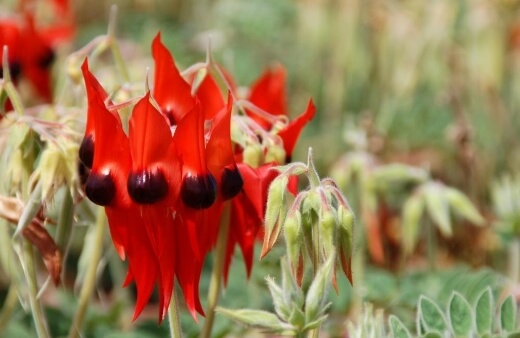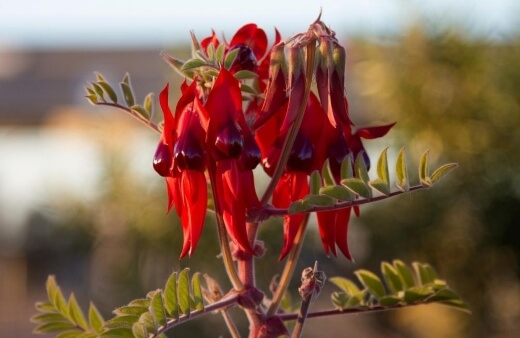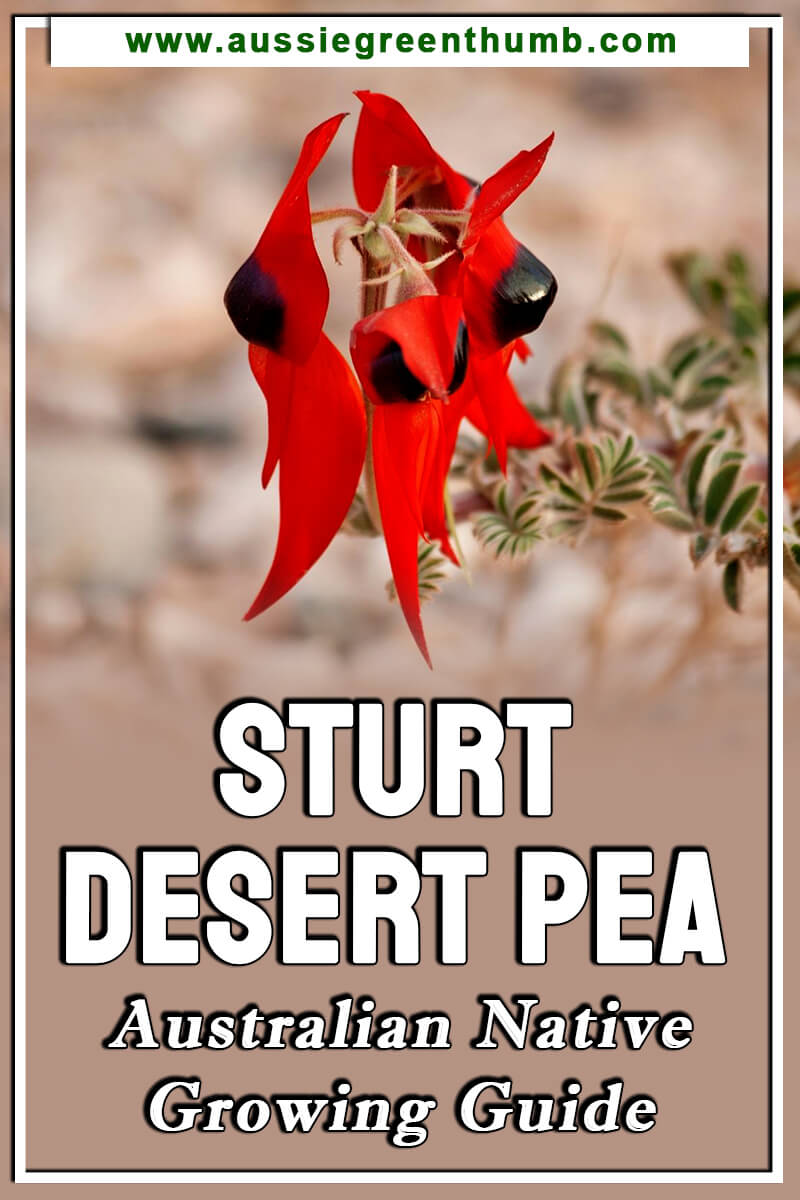Sturt desert pea is an incredible species of plant which is often found growing naturally in the outback. Sturt’s desert pea is an intricate creeping vine with bean-like, bright red blossoms that are incredibly eye-catching.
Sought after for cut flower arrangements, this interesting plant can actually be a fuss-free gardening companion. Here is everything you need to know to cultivate, care for and grow Sturt Desert Pea.
More...
What is Sturt Desert Pea?

Sturt desert pea is an endemic desert wildflower with an incredibly curious growth habit. Part of the Fabaceae family, the desert pea or Swainsona formosa occurs naturally in the arid woodland regions.
Swainsona formosa was discovered by William Dampier, and the name pays tribute to Isaac Swainson, who had cultivated and tested this flower extensively in England.
The desert pea grows as an elongated vine, with short, thick and erect stalks which produce oblong, deep red flowers and black kidney-shaped seeds.
This eye-catching cultivar can be grown in poorer soil conditions and thrives in rockeries, hanging baskets and tall-standing terra cotta pipes.
Sturt’s desert pea is a wonderfully prized endemic plant, so valued it has become the floral emblem for South Australia.
How to Grow Sturt’s Desert Pea

Sturt’s desert pea isn’t a difficult plant to cultivate. However, it’s essential to guarantee the right kind of conditions, or you may have a very sad looking plant.
This plant loves hot and dry weather. So, it’s essential to pick a spot with full-sun and fantastically draining soil. A north-facing position is often most ideal.
It is important to note that the desert pea does not do well with transplanting. As such, the spot you pick to plant needs to be the spot where it stays – whether that be in the ground or in a pot.
If planning on growing in a pot, choose a terracotta pot that is decently wide and tall. Choose a potting mix with plenty of pine bark and sand. To support more drainage, consider adding some perlite.
How to Propagate Swainsona formosa
Desert pea can be propagated by means of seed or by cutting, with seed being the most popular method as seeds are readily available from flowering plants.
Seeds do need optimal temperature conditions to germinate. As such, it’s essential to wait until spring before planting. Another issue with seeds is that due to the hard exterior, they will need to be treated before planting to guarantee germination.

Growing Sturt Desert Pea from Seeds
Some growers recommend soaking the seed in lukewarm water overnight. However, this tends to have variable results. As such, it is more advisable to scrub the coat. You will need to:


Get Your Free Guide:
Master Growing Australian Natives eBook
A Must Have Complete Guide for Every Australian Garden
Get Your Free Guide:
Master Growing Australian Natives eBook
A Must Have Complete Guide for Every Australian Garden
- Rub the seeds between two pieces of slightly coarse sandpaper.
- Once treated, sow the seed directly into the planting site or into the container.
- Keep the soil moist while germinating.
Again, it is not advisable to transplant your seedlings after sowing.
Growing Swainsona formosa from Cutting
If planning on growing Swainsona formosa from a cutting, you will need to have a little bit of patience. Here is what you’ll need to do:
- Remove a stem cutting from a healthy, thriving plant.
- Dip the cut end into rooting hormone and plant into a porous potting mix.
- Ideal potting mixes for cuttings should be five parts perlite and 1 part soil for optimum results.
Sturt’s Desert Pea Care

Once seedlings are established, they will need no supplementary watering. These plants are used to arid and dry conditions, and such overwatering can result in some major issues.
In the right conditions, your desert pea should begin producing flowers as early as four months after germinating. Once your flower stalks reach around 10cm height, you can fertilise your plants annually with a slow release native fertiliser.
Stems can be pruned back after flowering to remove spent flowers and regulate shape. Apart from these smaller care instructions, your desert pea won’t require too much other care.
Sturt Desert Pea – Bush Tucker Guide
Being the floral emblem for South Australia, this plant is naturally quite protected. Collecting these flowers and plants is illegal on Crown land without a permit and in other areas, collection on private land must be consented to by the owner.
Sturt desert pea is a leguminous plant that produces pea-like seeds. These seedpods develop after flowering when they can be collected, dried and used if needed.
Native Australians are known to eat the roasted seeds or make cakes with them by grinding the seeds and then baking them. Although Sturt desert pea seeds are mostly non-toxic and quite safe to eat, they don’t taste very pleasant and they contain trypsin inhibitors.
Trypsin is an essential enzyme that helps us break down proteins during digestion so it may not be ideal for us to eat these seeds.
Because this plant is protected and there is little information available regarding the use of the seeds for eating purposes, we recommended not utilising this bush tucker.
Common Sturt Desert Pea Pests, Problems and Diseases
One of the largest problems growers have is keeping their desert pea safe from snails. Planting rocks or throwing down crushed eggshells around your plants can help to naturally deter these pests.
Planting herbs like rosemary, sage, parsley and creeping thyme can also help to deter snails from your garden. Root rot is another common problem that can be a result of less than optimal drainage.
Be sure to monitor the moisture level in your soil regularly and protect plants from any heavy rains.
Desert Pea Frequently Asked Questions

Is Sturt Desert Pea annual or perennial?
The desert pea is treated as an annual plant. It sprouts readily within a year of germinating.
How long do Sturt Desert Peas flower for?
Flowers will bloom throughout the summer and spring.
Are Sturt's Desert Pea protected?
Throughout South Australia, the desert pea is considered a protected flora. Seeds cannot be collected from private land without the consent of the owner.
Are you looking for other Australian natives to add to your garden collection? Take a look at our list of 30 Best Endemic Flowers to Grow in Australia.
Start Growing Sturt’s Desert Pea today!
Just ensure you plant your Desert Pea somewhere with well-draining soil and plenty of sunshine. Make sure once you pick your spot, you stick to it too, because your desert pea won’t survive should it move.
If you’re looking for something to add some flavour to your garden, then the Sturt Desert Pea is the perfect choice for you.

Published on April 18, 2022 by Nathan Schwartz
Last Updated on September 19, 2025





I planted two Sturt peas plants in January 24 and although some of the fronds or runners have died, new ones are still growing. I have been surprised by the length of the runners. Do i cut the dead runners or leave them
I planted two Sturt Desert Peas in January 2025 and they are still flowering I live in Whyalla SA and they have had six-to-seven-foot lengths of flowers some of the stems are drying off and there are quite a few new ones with lots of flowers on them. Do I remove the one that are drying out. They have flourished really well where they are and I only watered then when first planted otherwise they were on there own.
Hi John,
They’re incredibly vigorous plants when they find the right spot, and stunning flowers make it well worth the space. Definitely cut back those dying stems though.
Sturt’s Desert Peas die back along the stem once they’ve flowered, so just keep trimming off the stems that have finished flowering to encourage new flowering stems.
As soon as flowers start to fade, just cut that stem back. The more often you do that, the more energy the plants can put into the younger stems to keep the flowering season going on and on and on.
Happy gardening!
Nathan